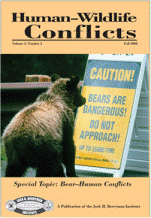Center, Internet, Wildlife Damage Management

Human–Wildlife Interactions
Date of this Version
2008
Document Type
Article
Abstract
Wildlife damage to crops is a widespread concern among agricultural producers and wildlife professionals. In the United States, raccoon (Procyon lotor) damage to field corn (Zea maize) has become a serious concern, as raccoon depredation to corn has increased significantly in recent years. However, little information is available to suggest the underlying factors responsible for recent increases in raccoon depredation on agricultural crops because there is a limited understanding of the ecological factors influencing wildlife damage to crops at local scales. During 2004, we initiated a study to elucidate the ecological factors influencing depredation to field corn by raccoons, and, in particular, to determine the relationship between local raccoon abundance and raccoon damage to corn. We used mark-recapture techniques to trap raccoons in 14 forest patches in northern Indiana and estimated raccoon abundance for each patch using the Huggins closed capture maximum likelihood approach in Program MARK™. All cornfields adjacent to the trapped forest patches were surveyed for raccoon damage to obtain patch-specific estimates of crop damage for each patch. We used the best subsets regression moderated by r2 and Akaike’s information criterion (AICc), as well as stepwise multiple linear regression to model the influence of raccoon abundance, raccoon sex and age ratios, and landscape characteristics (e.g., forest patch size, isolation) on the amount of damage incurred to cornfields by raccoons. Both best subsets and stepwise regression produced an optimal model that included raccoon abundance and the proportion of forest patch edge bordered by corn as important predictors of raccoon damage to corn. Both raccoon abundance and the proportion of forest patch edge bordered by corn were positively related to the amount of raccoon damage to corn. The results of our study support the supposition that recent increases in raccoon abundance throughout much of the midwestern United States likely have contributed to the concomitant increases in damage to agricultural crops observed in this region. Although current management regimes for raccoons appear to be ineffective at regulating raccoon populations at the landscape level, our results suggest that sustained localized management of raccoon populations may decrease the amount of damage incurred to cornfields at local scales.


Comments
Published in Human–Wildlife Conflicts Volume 2, Number 2, Pages 248-259, Fall 2008. Published and copyright by Jack H. Berryman Institute http://www.berrymaninstitute.org/journal/index.html